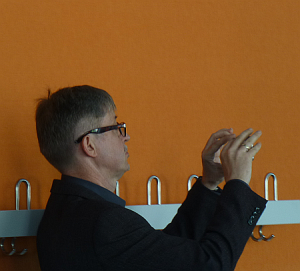Employee Morale: Measure. Talk. Improve. REPEAT! – Interview with Celpax‘ Rebecca Lundin
Prof. Dr. Peter Wald im Interview mit Rebeccy Lundin, Celpax Stockholm

This year’s HR Innovation Day is approaching. It is a good tradition to present the keynote speakers in interviews. My interviewee for today is Rebecca Lundin, Co-founder of Celpax from Stockholm. I am very pleased that she will give a keynote on the topic. „Real Time Employee Morale: Why measure daily?“. I have known Rebecca virtually for a long time and blogged on the application of the Celpax device at Unilever in Kleve in the Leipzig HRM blog. Rebecca was also kind enough to answer my „(5 (+1) Question/s on expectations on Human Resource Management“.
Peter: Rebecca, could you be so kind and introduce yourself as well as Celpax? How did the idea for Celpax, and especially the device come about?
Rebecca: Well, I’m one of the cofounders of Swedish Celpax. We interviewed more than 100 leaders to get to the product we have today. Leaders who had done remarkable things. And the product isn’t finished, we keep learning together with our users! In 2012 we launched the Celpax, a device to measure employee morale. Staff answer the question „How was your day?“ by pressing a green or a red smiley button as they go home. After they have pressed, they see the combined result from their colleagues. The online dashboard shows the result per day, week, month etc. You’ll see employee morale trends, the impact of a big management announcement, an All-Hands meeting, etc. Users tend to cross check with other Business KPI’s like productivity, safety, etc. It can also indicate signs of burnout among your people. So at Celpax we develop simple tech tools to get more people involved at work. And create a better society while at it! We’re a for-profit that want more people to wake up in the morning and feel GOOD about going to work.

Peter: What experiences have you had with the usage of your device so far? Many people wonder why the mood of employees should be measured in „real time“ because they think of annual employee surveys?
Rebecca: With a survey you get a lot of in depth explanations, with the Celpax you get insights while you improve. You do something today and you see the result tomorrow. We are in the business of simplicity and DIY (do it yourself). The annual survey kind of complements what we do: A heart rate monitor might not be a medical checkup, but all athletes use one to improve. It tells you how your training went, if you’re getting fit, we kind of do the same… Both are related to health, but not really comparable. The Celpax data tells you if the actions you take improve the employee morale. Do more of what makes people press green, and try to fix what makes people press red. The Celpax might not explain everything that is going on, or asses like a survey would, but if you do something today, tomorrow you’ll see the result of your action. So you can improve the employee experience and base actions on numbers, and not just guts. The recipe we learnt from our users is to Measure. Talk. Improve. REPEAT! Continuous improvement with People Analytics.
Peter: What do you recommend to personnel managers who are planning to introduce your device? How should they prepare? How about resistance of employees?
Our data shows that organizations where these conversations are happening, have higher employee morale, and take less time to recoup after a tough period. Some delegate to IT because it’s HR tech. But is your IT Director responsible for employee engagement? They seem to forget that company culture is not a self-playing piano. You need to DO something after you have asked a question that your employees have responded. It can be really small things, but you need to follow up and be prepared to share the results

Peter: What can the listeners expect from your Keynote in general?
Peter: Finally, a question I’d like to ask all the speakers. Why are you participating at the HR Innovation Day 2018?
Peter: Thank you very much today for your support of the HR Innovation Day. I look forward to listen to your keynote.
My Interviewee Rebecca Lundin studied Media & Communication and Political Science at the University of Lund, Sweden (1994-2000) and Economics at the IUI University in Uganda. She worked for Bombardier before moving on to tech companies like Zeemote and Southwing. Since 2011 she dedicates her time to improving workplaces with Celpax, a company designing and manufacturing simple tech tools to measure and boost morale at work.





